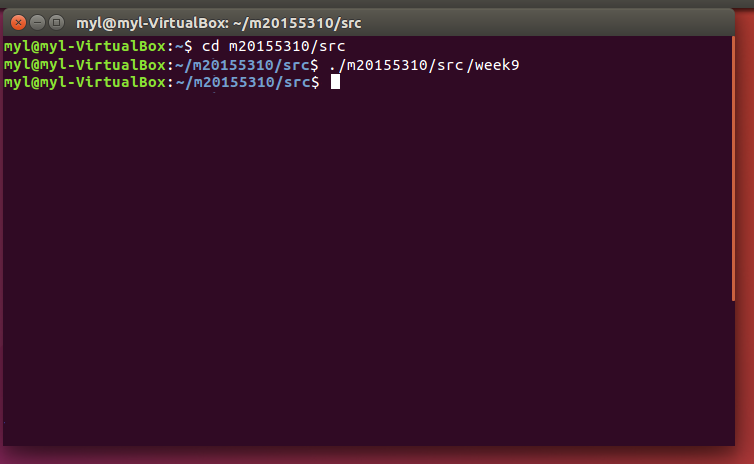2017-2018-1 20155310 《信息安全系统设计基础》 实现mypwd
2017-2018-1 20155310 《信息安全系统设计基础》 实现mypwd
作业要求:
1、学习pwd命令
2、研究pwd实现需要的系统调用(man -k; grep),写出伪代码
3、实现mypwd
4、测试mypwd
学习pwd命令
命令简介:
该命令用来显示目前所在的工作目录。指令英文原义:print work directory
执行权限 :All User
指令所在路径:/usr/bin/pwd 或 /bin/pwd
命令语法:
pwd [OPTION]...
命令参数:
| 参数 | 长参数 | 描述 |
|---|---|---|
| -L | --logical(无效) | 当目录为连接路径时,显示连接路径 |
| -P | --physical(无效) | 显示实际物理路径,而非使用连接(link)路径 |
| . | --help | 显示命令在线帮助(该参数无法使用) |
| . | --version | 显示命令版本信息(该参数无法使用) |
使用示例:
1:查看pwd命令的帮助信息
root@DB-Server init.d]# man pwd
PWD(1) User Commands PWD(1)
NAME
pwd - print name of current/working directory
SYNOPSIS
pwd [OPTION]...
DESCRIPTION
Print the full filename of the current working directory.
-L, --logical
use PWD from environment, even if it contains symlinks
-P, --physical
avoid all symlinks
--help display this help and exit
--version
output version information and exit
NOTE: your shell may have its own version of pwd, which usually supersedes the version described here. Please refer to your shell鈥檚 documentation for details about the
options it supports.
AUTHOR
Written by Jim Meyering.
REPORTING BUGS
Report bugs to <bug-coreutils@gnu.org>.
COPYRIGHT
Copyright 漏 2006 Free Software Foundation, Inc.
This is free software. You may redistribute copies of it under the terms of the GNU General Public License <http://www.gnu.org/licenses/gpl.html>. There is NO WARRANTY, to
the extent permitted by law.
SEE ALSO
The full documentation for pwd is maintained as a Texinfo manual. If the info and pwd programs are properly installed at your site, the command
info pwd
should give you access to the complete manual.
pwd 5.97 May 2011 PWD(1)
(END)
2:显示当前目录所在路径 pwd
[root@DB-Server networking]# pwd
/etc/sysconfig/networking
3:显示当前目录的物理路径 pwd –P
[root@DB-Server init.d]# cd /etc/init.d
[root@DB-Server init.d]# pwd -P
/etc/rc.d/init.d
4: 显示当前目录的连接路径:pwd -L
[root@DB-Server networking]# cd /etc/init.d
[root@DB-Server init.d]# pwd -L
/etc/init.d
[root@DB-Server init.d]# pwd
/etc/init.d
实现mypwd
代码如下:
#include <stdio.h>
#include <stdlib.h>
#include <dirent.h>
#include <sys/types.h>
#include <sys/stat.h>
#include <string.h>
#include <unistd.h>
#define MAX_DIR_DEPTH (256) //限制最大的目录深度
#define TRUE 1
#define FALSE 0
//根据文件名获取文件的inode-number
ino_t get_ino_byname(char *filename)
{
struct stat file_stat;
if(0 != stat(filename, &file_stat)) //stat()通过文件名filename获取文件信息,并保存在buf所指的结构体stat中
{
perror("stat");
exit(-1);
}
return file_stat.st_ino;
}
//根据inode-number, 在当前目录中查找对呀的文件名
char *find_name_byino(ino_t ino)
{
DIR *dp = NULL;
struct dirent *dptr = NULL;
char *filename = NULL;
if(NULL == (dp = opendir("."))) //opendir()打开一个目录,在失败的时候返回一个空的指针,成返回DIR结构体
{
fprintf(stderr, "Can not open Current Directory\n");
exit(-1);
}
else
{
while(NULL != (dptr = readdir(dp))) //readdir()用来读取目录。返回是dirent结构体指针
{
if(dptr->d_ino == ino)
{
filename = strdup(dptr->d_name); //strdup()将串拷贝到新建的位置处,返回一个指针,指向为复制字符串分配的空间;如果分配空间失败,则返回NULL值.
break;
}
}
closedir(dp);
}
return filename;
}
int main(int argc, char *argv[])
{
//记录目名的栈
char *dir_stack[MAX_DIR_DEPTH];
unsigned current_depth = 0;
while(TRUE)
{
ino_t current_ino = get_ino_byname("."); //通过特殊的文件名"."获取当期目录的inode-number
ino_t parent_ino = get_ino_byname(".."); //通过特殊的文件名".."获取当前目录的父目录的inode-number
if(current_ino == parent_ino)
break; //达到根目录,推出循环
/*两个inode-number不一样*/
chdir(".."); //更改当前工作目录,变为当前目录的父目录
dir_stack[current_depth++] = find_name_byino(current_ino); //"文件名"地址存放
if(current_depth >= MAX_DIR_DEPTH) //路径名太深
{
fprintf(stderr, "Directory tree is too deep.\n");
exit(-1);
}
}
int i = current_depth - 1;
for(i = current_depth - 1; i >= 0; i--) //打印路径
{
fprintf(stdout, "/%s", dir_stack[i]);
}
fprintf(stdout, "%s\n", current_depth == 0 ? "/" : "");
return 0;
}
/*
dirent结构体:
struct dirent
{
long d_ino; //inode number 索引节点号
off_t d_off; //offset to this dirent 在目录文件中的偏移
unsigned short d_reclen;// length of this d_name 文件名长
unsigned char d_type; //the type of d_name 文件类型
char d_name [NAME_MAX+1]; //file name (null-terminated) 文件名,最长255字符
};
DIR结构体:
struct __dirstream
{
void *__fd; // `struct hurd_fd' pointer for descriptor.
char *__data; // Directory block.
int __entry_data; // Entry number `__data' corresponds to.
char *__ptr; // Current pointer into the block.
int __entry_ptr; // Entry number `__ptr' corresponds to.
size_t __allocation;// Space allocated for the block.
size_t __size; // Total valid data in the block.
__libc_lock_define (, __lock) // Mutex lock for this structure.
};
typedef struct __dirstream DIR;
结构体stat:
struct stat {
dev_t st_dev; //文件的设备编号
ino_t st_ino; //节点
mode_t st_mode; //文件的类型和存取的权限
nlink_t st_nlink; //连到该文件的硬连接数目,刚建立的文件值为1
uid_t st_uid; //用户ID
gid_t st_gid; //组ID
dev_t st_rdev; //(设备类型)若此文件为设备文件,则为其设备编号
off_t st_size; //文件字节数(文件大小)
unsigned long st_blksize; //块大小(文件系统的I/O 缓冲区大小)
unsigned long st_blocks; //块数
time_t st_atime; //最后一次访问时间
time_t st_mtime; //最后一次修改时间
time_t st_ctime; //最后一次改变时间(指属性)
}; */
运行截图:




